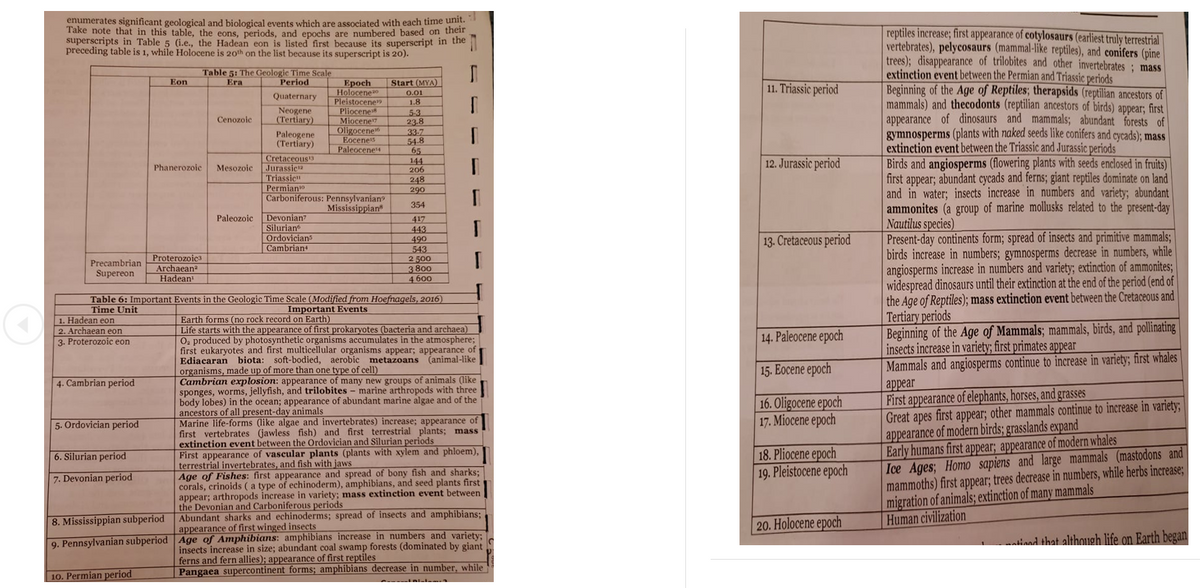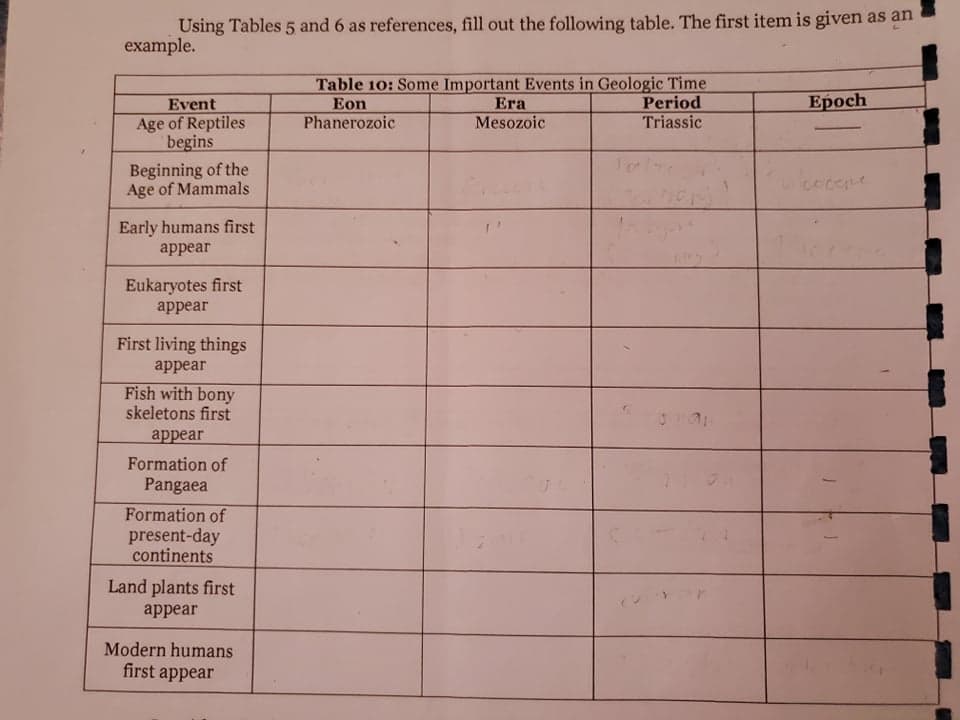example. Table 10: Some Important Events in Geologic Time Era Mesozoic Period Triassic Event Eon Epoch Phanerozoic Age of Reptiles begins Beginning of the Age of Mammals Early humans first appear Eukaryotes first appear First living things appear Fish with bony skeletons first аppear Formation of Pangaea Formation of present-day continents Land plants first appear Modern humans first appear
example. Table 10: Some Important Events in Geologic Time Era Mesozoic Period Triassic Event Eon Epoch Phanerozoic Age of Reptiles begins Beginning of the Age of Mammals Early humans first appear Eukaryotes first appear First living things appear Fish with bony skeletons first аppear Formation of Pangaea Formation of present-day continents Land plants first appear Modern humans first appear
Biology Today and Tomorrow without Physiology (MindTap Course List)
5th Edition
ISBN:9781305117396
Author:Cecie Starr, Christine Evers, Lisa Starr
Publisher:Cecie Starr, Christine Evers, Lisa Starr
Chapter11: Evidence Of Evolution
Section: Chapter Questions
Problem 1VQ
Related questions
Question
Based on the table 5 and 6 complete the table 10

Transcribed Image Text:enumerates significant geological and biological events which are associated with each time unit.
Take note that in this table, the eons, periods, and epochs are numbered based on their
superscripts in Table 5 (i.e., the Hadean eon is listed first because its superseript in the
preceding table is 1, while Holocene is 20th on the list because its superscript is 20).
reptiles increase; first appearance of cotylosaurs (earliest truly terrestrial
vertebrates), pelycosaurs (mammal-like reptiles), and conifers (pine
trees); disappearance of trilobites and other invertebrates; mass
extinction event between the Permian and Triassic periods
Beginning of the Age of Reptiles; therapsids (reptilian ancestors of
mammals) and thecodonts (reptilian ancestors of birds) appear; first
appearance of dinosaurs and mammals; abundant forests of
gymnosperms (plants with naked seeds like conifers and cycads); mass
extinction event between the Triassic and Jurassic periods
Birds and angiosperms (flowering plants with seeds enclosed in fruits)
first appear; abundant cycads and ferns; giant reptiles dominate on land
and in water; insects increase in numbers and variety; abundant
ammonites (a group of marine mollusks related to the present-day
Nautilus species)
Present-day continents form; spread of insects and primitive mammals;
birds increase in numbers; gymnosperms decrease in numbers, while
angiosperms increase in numbers and variety; extinction of ammonites;
widespread dinosaurs until their extinction at the end of the period (end of
the Age of Reptiles); mass extinction event between the Cretaceous and
Tertiary periods
Beginning of the Age of Mammals; mammals, birds, and pollinating
insects increase in variety; first primates appear
Mammals and angiosperms continue to increase in variety; first whales
Table 5: The Geologic Time Scale
Era
Eon
Period
Epoch
Holoceneao
Pleistocene
Pliocene
Miocene7
Oligocene
Eocenes
Paleocene
Start (MYA)
11. Triassic period
0.01
1.8
Quaternary
Neogene
(Tertiary)
5-3
23.8
33-7
54-8
65
144
206
Cenozoic
Paleogene
(Tertiary)
Cretaceous
Jurassica
Triassic
Permiano
Carboniferous: Pennsylvanian
12. Jurassic period
Phanerozoic
Mesozoic
248
290
354
Mississippian
Paleozoic Devonian7
Silurian
Ordovicians
Cambrian+
417
443
490
543
2 500
3 800
4 600
13. Cretaceous period
Proterozoica
Archaean
Hadean
Precambrian
Supereon
Table 6: Important Events in the Geologic Time Scale (Modified from Hoefnagels, 2016)
Time Unit
Important Events
Earth forms (no rock record on Earth)
Life starts with the appearance of first prokaryotes (bacteria and archaea)
Oa produced by photosynthetic organisms accumulates in the atmosphere;
first eukaryotes and first multicellular organisms appear; appearance of
Ediacaran biota: soft-bodied, aerobic metazoans (animal-like
organisms, made up of more than one type of cell)
Cambrian explosion: appearance of many new groups of animals (like .
sponges, worms, jellyfish, and trilobites - marine arthropods with three
body lobes) in the ocean; appearance of abundant marine algae and of the
ancestors of all present-day animals
Marine life-forms (like algae and invertebrates) increase; appearance of
first vertebrates (jawless fish) and first terrestrial plants; mass
extinction event between the Ordovician and Silurian periods
First appearance of vascular plants (plants with xylem and phloem),
terrestrial invertebrates, and fish with jaws
Age of Fishes: first appearance and spread of bony fish and sharks;
corals, crinoids ( a type of echinoderm), amphibians, and seed plants first
appear; arthropods increase in variety; mass extinction event between
the Devonian and Carboniferous periods
Abundant sharks and echinoderms; spread of insects and amphibians;
appearance of first winged insects
1. Hadean eon
2. Archaean eon
3. Proterozoic eon
14. Paleocene epoch
15. Eocene epoch
4. Cambrian period
appear
First appearance of elephants, horses, and grasses
Great apes first appear; other mammals continue to increase in variety;
appearance of modern birds; grasslands expand
Early humans first appear; appearance of modern whales
Ice Ages; Homo sapiens and large mammals (mastodons and
mammoths) first appear; trees decrease in numbers, while herbs increase;
migration of animals; extinction of many mammals
Human civilization
16. Oligocene epoch
17. Miocene epoch
5. Ordovician period
18. Pliocene epoch
19. Pleistocene epoch
6. Silurian period
7. Devonian period
8. Mississippian subperiod
9. Pennsylvanian subperiod Age of Amphibians: amphibians increase in numbers and variety;
20. Holocene epoch
atinad that although life on Earth began
insects increase in size; abundant coal swamp forests (dominated by giant
ferns and fern allies); appearance of first reptiles
Pangaea supercontinent forms; amphibians decrease in number, while
on
10. Permian period

Transcribed Image Text:Using Tables 5 and 6 as references, fill out the following table. The first item is given as an
example.
Table 10: Some Important Events in Geologic Time
Mesozoic
Era
Ерoch
Event
Eon
Triassic
Period
begins
Age of Reptiles
Phanerozoic
Beginning of the
Age of Mammals
Early humans first
appear
Eukaryotes first
appear
First living things
appear
Fish with bony
skeletons first
аppear
Formation of
Pangaea
Formation of
present-day
continents
Land plants first
appear
Modern humans
first appear
Expert Solution
This question has been solved!
Explore an expertly crafted, step-by-step solution for a thorough understanding of key concepts.
This is a popular solution!
Trending now
This is a popular solution!
Step by step
Solved in 2 steps

Knowledge Booster
Learn more about
Need a deep-dive on the concept behind this application? Look no further. Learn more about this topic, biology and related others by exploring similar questions and additional content below.Recommended textbooks for you

Biology Today and Tomorrow without Physiology (Mi…
Biology
ISBN:
9781305117396
Author:
Cecie Starr, Christine Evers, Lisa Starr
Publisher:
Cengage Learning


Biology Today and Tomorrow without Physiology (Mi…
Biology
ISBN:
9781305117396
Author:
Cecie Starr, Christine Evers, Lisa Starr
Publisher:
Cengage Learning
